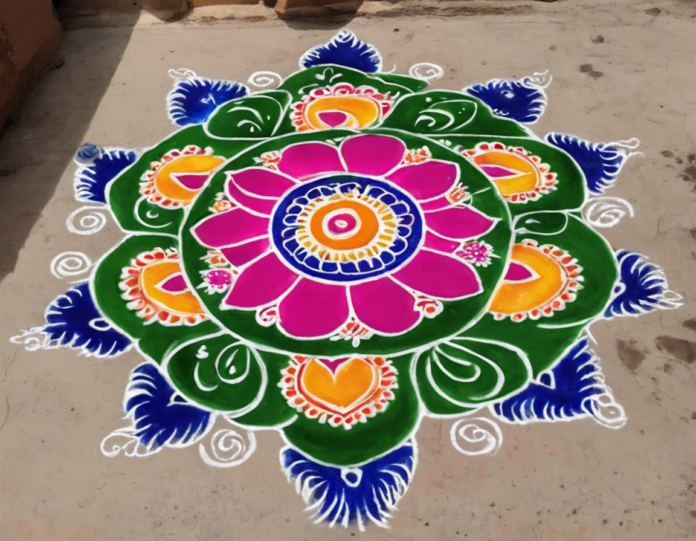Ugadi, also known as Gudi Padwa in some regions, marks the beginning of the Hindu lunar calendar and is celebrated with great enthusiasm in several parts of India. One of the most prominent traditions associated with Ugadi is the creation of rangoli designs. Rangoli, a colorful art form made on the floor using vibrant powders, rice, or flower petals, is believed to bring good luck and prosperity to the household. As we approach Ugadi in 2024, here are seven stunning Ugadi rangoli designs to inspire you:
Traditional Peacock Design
The peacock is a symbol of beauty and grace in Indian culture. Create a peacock rangoli by drawing the peacock’s body, feathers, and majestic tail using a combination of bold colors like blue, green, and gold. Add intricate patterns and motifs to enhance the intricacy of the design.
Floral Patterns
Flowers symbolize freshness, purity, and abundance. Create a floral rangoli design using a variety of flower petals like marigold, rose, and jasmine. You can also use colored powders to create intricate floral patterns inspired by traditional Indian motifs.
Lotus Mandala
The lotus flower holds great spiritual significance in Hinduism. Create a lotus mandala rangoli design by drawing multiple concentric circles and petals to resemble a blooming lotus flower. Use vibrant colors like pink, orange, and yellow to bring out the intricacy of the design.
Paisley Patterns
Paisley, also known as the mango motif, is a popular design element in Indian art and textiles. Incorporate paisley patterns into your rangoli design by creating intricate mango-shaped motifs with curved lines and swirls. Add dots and borders to embellish the design further.
Diya Kolam
Diyas, or oil lamps, are an essential part of Indian festivals and rituals. Create a diya kolam rangoli design by drawing a series of interconnected diyas using bright colors like red, yellow, and orange. You can also add flames and geometric patterns to enhance the visual appeal.
Geometric Patterns
Geometric patterns convey harmony and order in rangoli designs. Experiment with circles, squares, triangles, and lines to create a mesmerizing geometric rangoli design. Play with symmetry and color contrasts to make the design visually striking.
Ganesha Motif
Lord Ganesha, the elephant-headed deity, is revered as the remover of obstacles and the god of wisdom and intellect. Create a Ganesha motif rangoli design by drawing Lord Ganesha’s image surrounded by intricate patterns and motifs. Use vibrant colors and embellishments to bring out the divine essence of the design.
In conclusion, rangoli designs are a beautiful way to add color, creativity, and positivity to your Ugadi celebrations. Whether you prefer traditional motifs or contemporary patterns, let your imagination soar as you create stunning rangoli art to welcome the new year with joy and prosperity.
Frequently Asked Questions (FAQs)
Q: What materials are commonly used to make rangoli designs?
A: Common materials used for rangoli designs include colored powders, rice flour, flower petals, and chalk.
Q: How long do rangoli designs typically last?
A: Rangoli designs made with powders or petals can last anywhere from a few hours to a few days, depending on the environment and foot traffic.
Q: Are there any specific guidelines or rules for creating rangoli designs?
A: While there are no strict rules, rangoli designs often incorporate symmetry, patterns, and auspicious motifs like lotus flowers, peacocks, and geometric shapes.
Q: Can rangoli designs be made indoors?
A: Yes, rangoli designs can be made indoors using materials like chalk or colored powders on flat surfaces like floors or tables.
Q: What is the significance of rangoli in Indian culture?
A: Rangoli is believed to bring good luck, prosperity, and positive energy to the home. It is also considered a form of artistic expression and a way to welcome guests and deities.
Q: Can beginners create intricate rangoli designs?
A: Yes, beginners can start with simple designs and gradually move on to more complex patterns as they gain confidence and experience in creating rangoli art.
Q: Are there any regional variations in rangoli designs?
A: Yes, different regions in India have their own styles and motifs for rangoli designs, influenced by local customs, traditions, and cultural practices.
Q: How can I preserve a rangoli design for a longer duration?
A: To preserve a rangoli design, you can spray a light mist of water to set the colors or place a transparent sheet over the design to protect it from wind or foot traffic.
Q: Can rangoli designs be made for other occasions besides festivals?
A: Yes, rangoli designs can be created for various occasions like weddings, birthdays, housewarming ceremonies, and religious ceremonies to add beauty and auspiciousness to the celebrations.
Q: Is there a specific time of day to create rangoli designs?
A: Traditionally, rangoli designs are created in the early morning or evening hours to welcome the dawn or dusk, as these times are considered auspicious in Indian culture.

